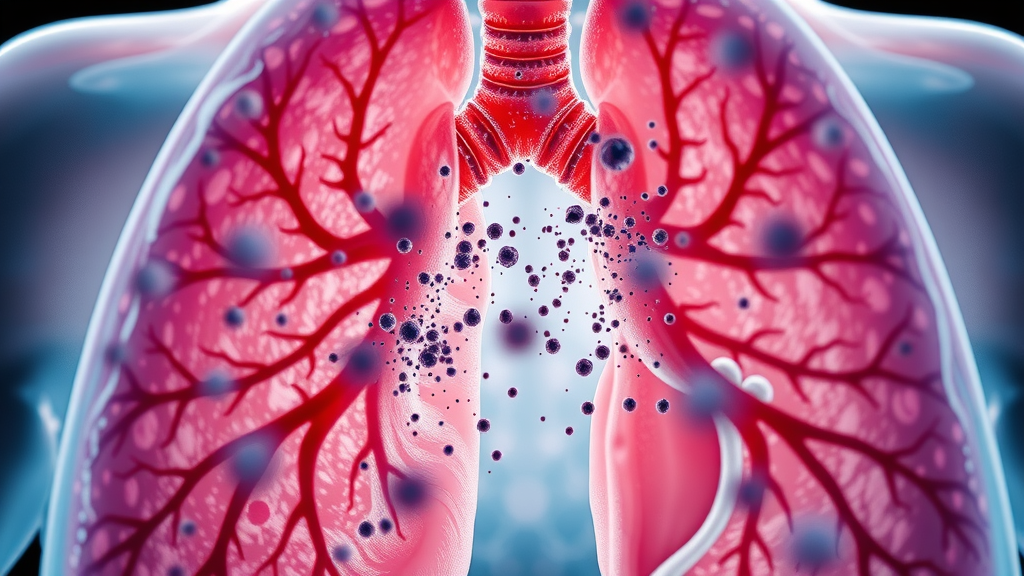Every breath counts, especially in North Carolina’s industrial regions. Many of us unknowingly endure polluted air that steadily harms our lungs. Understanding how industrial emissions impact your lung health empowers you to protect yourself and your loved ones from long-term respiratory risks.
This article goes beyond the headlines to uncover how industrial emissions in North Carolina’s manufacturing hubs affect air quality, raise the risk of respiratory illness, and why robust interventions are overdue. Understand your environment and your health risks.

Every Breath Counts: Understanding Industrial Emissions North Carolina Lung Health
Industrial emissions remain a silent, yet powerful force shaping the landscape of North Carolina lung health and air quality. Manufacturing complexes, sprawling power plants, and chemical processing facilities dot North Carolina, releasing a mix of air pollution—from particulate matter to nitrogen oxide and sulfur dioxide—directly impacting the region's air quality. These emissions make their way across both urban and rural communities, impacting air quality and raising the stakes for public health.
Throughout North Carolina, scientific studies consistently find that areas neighboring major industrial corridors report higher rates of lung disease, decreased lung function, and increases in premature death from respiratory conditions.
For residents of North Carolina, the daily impact of industrial emissions is not just a distant, abstract issue. It is about the air filling each lungful, shaping children’s growth, aggravating asthma, and potentially raising the risk of serious, irreversible health issues. Industrial air pollution often goes unnoticed because many of its key threats are invisible, yet the consequences grow sharper each year.
Armed with the facts about air pollutants and the latest findings from groups like the American Lung Association, North Carolinians are better prepared to demand cleaner air, improved industrial controls, and stronger state oversight. When it comes to lung health, every measure counts—and collective action is more urgent than ever.
The Invisible Threat of Air Pollution in North Carolina's Manufacturing Hubs
Amid the hum of machinery and the bustle of commerce, a less visible danger lurks in North Carolina’s industrial regions: air pollution. Fine particulate matter, ozone, and other toxins released from manufacturing plants and power plants can drift for miles, infiltrating urban and suburban neighborhoods alike. Recent county-level air quality reports highlight persistent air pollution “hotspots” where residents face greater overall health impacts, especially those living near major industrial corridors in North Carolina.
Many pollutants—such as PM2.5 (fine particle pollution) and nitrogen oxides—can’t be detected by sight or smell, yet they find their way deep into the respiratory tract, causing irritation and long-term damage. These pollutants are linked not only to everyday respiratory issues but also to increased rates of lung cancer and chronic bronchitis, as confirmed by epidemiological studies. Public awareness of these invisible dangers is essential, as is holding both companies and regulatory agencies accountable for ensuring that all communities—regardless of income, race, or zip code—have access to clean air and better health outcomes.

"Every day, the air we breathe shapes our future health. In North Carolina, industrial emissions are an urgent part of this story."
What You'll Learn About Industrial Emissions North Carolina Lung Health
The science behind industrial emissions and air quality
The impact of air pollutants on lung health
Links between air pollution and lung cancer
Current regulations and their effectiveness
Steps residents can take to protect lung health
Air Quality in North Carolina: The Scope of the Problem
North Carolina has a vibrant economy fueled by manufacturing, logistics, and energy production, but this industrial growth contributes to worsening air quality and air pollution challenges. According to the American Lung Association, North Carolina frequently struggles with air quality, landing several communities on lists for poor ozone and high particle pollution. Areas near manufacturing sites, power plants, and dense urban centers often experience the highest concentrations of hazardous air pollutants. The consequences include not only visible health effects—like coughing and wheezing—but also a dangerous rise in silent diseases, including reduced lung function and lung cancer.
Why does this matter? In addition to immediate respiratory irritation, chronic exposure to even low levels of particulate matter can lead to diagnosed health conditions that burden families and public health agencies alike. The impact is particularly severe for people with asthma, children, older adults, and those with underlying health issues. State-level reports consistently cite air quality problems as critical hurdles in the fight for better public health. If unchecked, these pollutants also contribute to climate change and broader environmental degradation, compounding health effects for future generations.
While understanding the sources and effects of industrial emissions is crucial, it's equally important to recognize how lifestyle choices can help mitigate some of the inflammation caused by air pollution. For those interested in supporting their lung and overall health, exploring top superfoods that help combat inflammation may offer additional protection against the harmful effects of environmental toxins.
Air Pollutant Sources: Manufacturing, Power Plants, and More
The chief contributors to poor air quality in North Carolina are undeniably its industrial sectors—manufacturing facilities, coal-fired power plants, cement factories, and transportation infrastructure—all major sources of particulate matter and air pollution. These sites emit massive volumes of nitrogen oxides, sulfur dioxides, volatile organic compounds, and most dangerously, fine particulate matter. Older industrial plants, especially those predating recent environmental standards, often operate with outmoded pollution controls, intensifying their impact on air quality.
But industry isn’t the sole culprit. Vehicles, agriculture, and residential heating further add to the toxic cocktail that fills the region’s skies. The cumulative result is a patchwork of pollution “hot spots” scattered throughout the state. Researchers from the American Lung Association have documented how air pollutants from industrial clusters can travel dozens of miles—with some studies indicating pollutant drift from power plants in one county significantly degrading air quality two counties away. To reverse course, reduction must happen across every sector.

Mapping Air Pollution Hotspots in North Carolina
Analysis of air monitoring data across North Carolina reveals distinct geographic patterns in air pollution and particulate matter concentrations. Urban centers like Charlotte, Raleigh, and Fayetteville frequently report high concentrations of particulate matter and ozone, largely due to clustered industrial sites and converging transportation corridors. Satellite imagery and ground-level measurements both highlight industrial belts surrounding central manufacturing hubs as persistent “red zones.” These areas correspond with increased emergency room visits for respiratory issues and higher rates of adult and childhood lung disease.
Even rural regions aren’t immune. The drift of air pollutants means that small towns adjacent to large plants often experience levels of air pollution on par with or worse than city centers. Populations most impacted tend to be lower-income and communities of color, underscoring the urgent need for environmental justice. North Carolina’s air quality maps are a stark reminder that industrial emissions aren’t just a localized nuisance—they’re a statewide public health hazard demanding robust interventions.
The Link Between Industrial Emissions and Lung Health
The relationship between industrial emissions, North Carolina lung health, and air quality is clear: higher concentrations of air pollutants—especially fine and ultrafine particulate matter—are linked to increased respiratory illness and decreased lung function. When inhaled, these particles can penetrate deep into the lungs, bypassing natural defenses and causing inflammation, tissue damage, and a weakening of the immune response. Researchers warn that these exposures, even at moderate levels, can build up over time, lowering lung function and raising the likelihood of disease.
For residents living near manufacturing plants or transportation corridors, the cumulative exposure to air pollutants raises the incidence of asthma in children, chronic obstructive pulmonary disease (COPD), and other chronic lung conditions. Alarmingly, data from the American Lung Association and several public health agencies show a correlation between areas with higher emissions and increased rates of lung cancer. By understanding these direct links, communities can better advocate for meaningful industrial oversight and health protections.
Particulate Matter and Its Effect on Lung Function
Fine particles (PM2.5) from smokestacks
Ozone and respiratory irritation
Chronic bronchitis and asthma triggers
Of all air pollutants, fine particulate matter (PM2.5) stands out for its profound effect on lung function. These microscopic particles, often produced in abundance by industrial smokestacks and diesel engines, easily evade the nose and throat’s natural filtration system. Once inhaled, they lodge deep within lung tissue, provoking inflammation, exacerbating asthma, and promoting the development of chronic bronchitis. Children, older adults, and anyone with pre-existing lung conditions are particularly susceptible to this damage.
Ozone pollution only intensifies the problem, irritating delicate respiratory linings and triggering coughing, chest tightness, and shortness of breath—especially during high-ozone days common in summer months. The result? People living near high-emission zones often experience more missed days of school and work, higher health care costs, and a lower overall quality of life. Reducing particulate matter is one of the most effective ways to defend lung function and ensure a healthier, more resilient population.
Industrial Air Pollutants: Carcinogens and Lung Cancer Risk
Beyond immediate respiratory problems, the long-term presence of carcinogenic air pollutants poses a grave risk. Manufacturing sites and power plants in North Carolina emit chemicals such as benzene, formaldehyde, arsenic, and heavy metals—substances known to be carcinogenic when inhaled regularly. Several peer-reviewed studies and American Lung Association reports have linked living near industrial corridors to increased rates of lung cancer, even among non-smokers.
Regular exposure to these industrial emissions doesn’t just affect day-to-day lung health—it changes the lifetime odds of developing serious health conditions like lung cancer. The danger is heightened for communities with limited healthcare access, magnifying disparities that already exist across the state. For these at-risk groups, every reduction in air pollution exposure means more lives saved and healthier futures secured.
"Studies have repeatedly found elevated lung cancer rates near industrial corridors."

Regulatory Response: Has the Clean Smokestacks Act Made a Difference?
North Carolina’s landmark Clean Smokestacks Act was introduced in 2002 to tackle air pollution and improve air quality from the state’s dirtiest power plants. By mandating drastic reductions in nitrogen oxides and sulfur dioxide emissions, the law aimed to restore air quality and safeguard public health. Over the following decade, reports show meaningful improvement: overall emissions from coal-fired plants dropped by over 70%, resulting in clearer skies and fewer high ozone advisory days in impacted areas.
However, the fight is far from over. While the Clean Smokestacks Act curbed pollution from large point sources, loopholes, enforcement gaps, and industrial growth in other sectors—like manufacturing and shipping—threaten to erode these gains. Research suggests that while ozone and PM2.5 levels have declined, many communities still experience levels above recommended public health thresholds, particularly on hot, stagnant summer days. Continuous monitoring and expanded regulation are critical if North Carolina hopes to build on the Act’s early successes.
Comparing Pre- and Post-Clean Smokestacks Act Air Quality and Lung Health Metrics in North Carolina
Metric |
Before Act (Pre-2002) |
After Act (Post-2010) |
|---|---|---|
Nitrogen Oxide Emissions (tons/year) |
150,000 |
40,000 |
Sulfur Dioxide Emissions (tons/year) |
400,000 |
115,000 |
High Ozone Alert Days |
50–65 |
15–25 |
Pediatric Asthma Admissions (per 10,000) |
11.2 |
7.0 |
Lung Cancer Incidence (per 100,000) |
73 |
62 |
Gaps in Enforcement and Ongoing Challenges
Despite the clean smokestacks act’s measurable progress, gaps in enforcement and new industrial activities threaten to undermine its gains. Some power plants and manufacturers deploy the latest emission controls, while others exploit outmoded equipment or reporting loopholes. Inspections are often sporadic, and regulatory fines may not provide enough deterrent to meaningfully reduce overall emissions.
Additional challenges include population growth, rising transportation emissions, and shifting industrial practices. As regulatory attention focuses on large point sources, smaller industrial and emerging sectors sometimes escape scrutiny. Community advocacy is pivotal in spotlighting these enforcement gaps and ensuring North Carolina continues moving toward truly clean air and healthier lungs for all.
What North Carolinians Can Do to Protect Lung Health
Check local air quality alerts
Limit outdoor activities on high pollution days
Advocate for stricter emissions controls
Use air purifiers at home
While policy changes and tighter regulation are essential, individuals and families can also take practical steps to defend their lung health amid ongoing industrial air pollution and declining air quality. Checking daily air quality alerts through official websites or local news channels helps inform safe outdoor activities, especially during “Code Orange” or “Code Red” days linked to high concentrations of ozone or particulate matter. On poor air quality days, staying indoors, using air purifiers, and sealing windows can significantly reduce exposure to airborne toxins.
More broadly, North Carolinians can amplify their voices in community meetings, join local advocacy groups, or directly petition lawmakers for stricter emissions standards and better enforcement of existing health protections. Every action, no matter how small, collectively drives the state toward a cleaner, healthier future. Protecting lung health is a community effort—make your voice heard and inspire others to demand change.

People Also Ask About Industrial Emissions North Carolina Lung Health
How does industrial pollution affect respiratory health?
Answer: Industrial pollution increases airborne particulate matter and chemicals linked to respiratory issues such as asthma, chronic bronchitis, and decreased lung function. Long-term exposure can also increase the risk of lung cancer.
What is causing poor air quality in North Carolina?
Answer: Poor air quality in North Carolina stems largely from industrial emissions, vehicular traffic, power plants, and certain agricultural practices. Industrial sources remain the leading culprits in many regions.
What is the most polluted city in NC based on air quality?
Answer: According to recent data, Charlotte and Fayetteville often report the highest particulate matter levels and ozone concentrations due to industrial activity and urban congestion.

Which US state has the worst air pollution?
Answer: California consistently ranks as the state with the worst air pollution, although numerous industrial counties in the Midwest and Southeast, including North Carolina, face significant challenges.
Key Takeaways on Industrial Emissions North Carolina Lung Health
Industrial emissions remain a leading source of poor air quality in North Carolina.
Lung health is clearly impacted by high levels of particulate matter and other pollutants.
Policy measures like the Clean Smokestacks Act have contributed improvements, but enforcement gaps remain.
Community and individual action are vital to further protect public health.

FAQs: Industrial Emissions North Carolina Lung Health
Can home air filters reduce health risks from industrial emissions in North Carolina?
Yes. High-efficiency particulate air (HEPA) filters can remove fine particulate matter and other air pollutants indoors, significantly reducing health risks, especially for vulnerable groups like children and the elderly.What role do local advocacy groups play in air quality initiatives?
Local advocacy groups help raise community awareness, push for stricter emissions standards, organize public events, and serve as vital links between residents and policymakers aiming for cleaner air in North Carolina.Is lung health equally affected in urban and rural areas?
Both urban and rural areas experience health impacts. Urban centers face dense pollution from industry and traffic, while rural regions downwind of major plants may face similar or greater risks due to pollutant drift.Are there federal regulations that impact North Carolina industrial emission standards?
Yes. Federal laws such as the Clean Air Act establish baseline standards for industrial emissions nationwide, which are enforced alongside North Carolina’s own environmental regulations and policies.
Conclusion: Why Action on Industrial Emissions North Carolina Lung Health Can't Wait
"Protecting our air is an investment in the future of every North Carolinian’s health. Demand clean air, stronger laws, and a community committed to lung health."
If you’re passionate about safeguarding your health and staying ahead of environmental risks, it’s wise to keep up with the latest public health recommendations. For a broader perspective on how national health guidelines can empower North Carolinians to make informed choices, explore the most recent CDC vaccine recommendations and insights for health-conscious adults.
By combining environmental awareness with proactive wellness strategies, you can take meaningful steps toward a healthier, more resilient future for yourself and your community.
Sources
American Lung Association – https://www.lung.org/research/sota/state-of-the-air/north-carolina
NC Department of Environmental Quality – https://deq.nc.gov/about/divisions/air-quality
EPA Air Trends: North Carolina – https://www.epa.gov/air-trends/air-quality-north-carolina
Industrial emissions in North Carolina significantly impact lung health, with pollutants from manufacturing facilities, power plants, and vehicles contributing to respiratory issues among residents. The American Lung Association’s report, “New Report: Transition to Zero-Emission Trucks Could Save Hundreds of Lives in North Carolina,” highlights that adopting zero-emission trucks could prevent up to 1,713 deaths and yield $18.8 billion in public health benefits for the state. (lung.org)
Additionally, the North Carolina Department of Health and Human Services provides detailed information on ozone pollution, explaining its formation, health effects, and protective measures. Ozone exposure can lead to respiratory system irritation, impaired breathing, and aggravated asthma, emphasizing the need for public awareness and preventive actions. (epi.dph.ncdhhs.gov)
For a comprehensive understanding of how industrial emissions affect lung health in North Carolina, these resources offer valuable insights and guidance.
 Add Row
Add Row  Add
Add 




Write A Comment